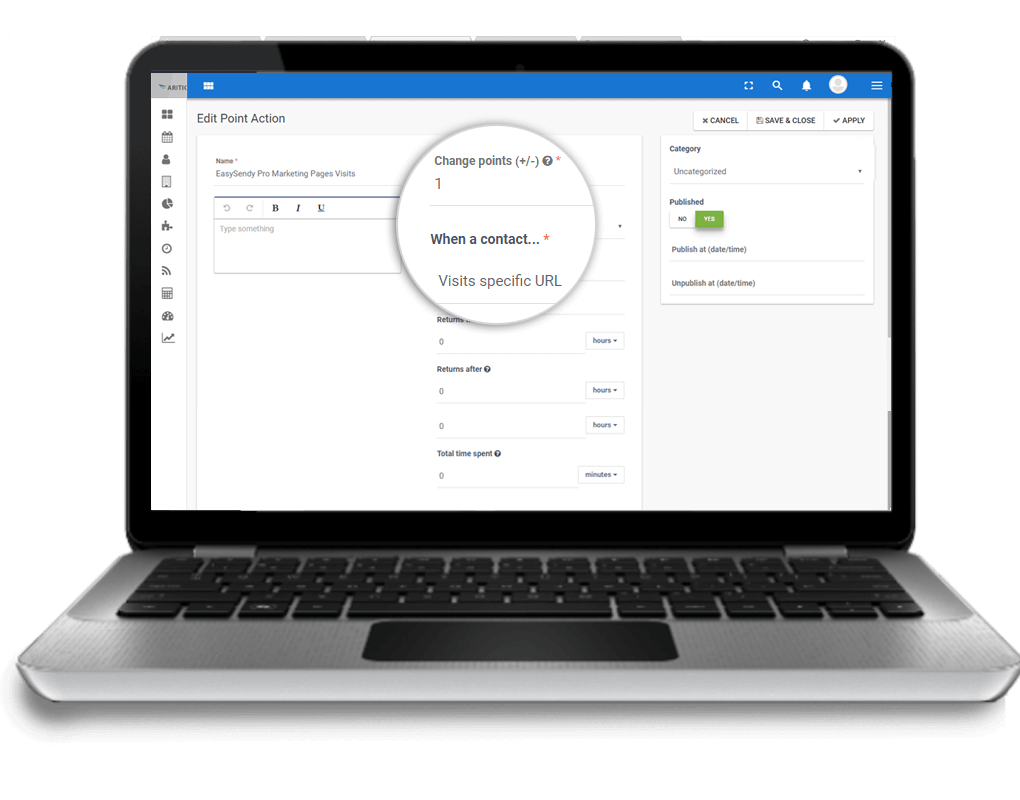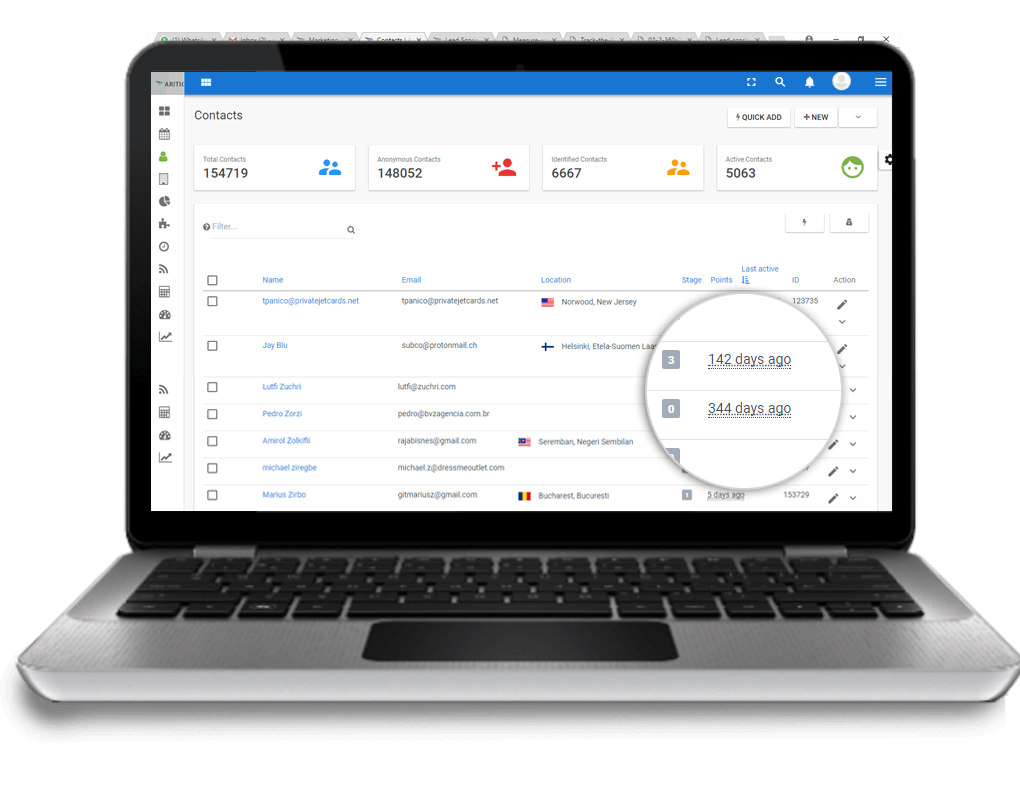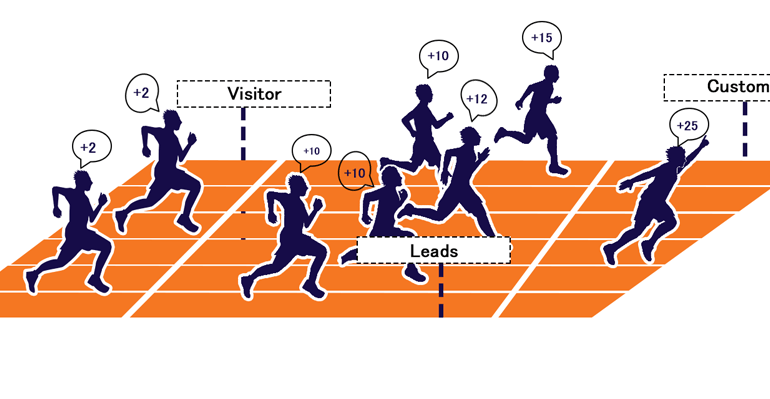
A marketing automation tool can help you generate a high volume of leads. The challenge is to filter out the bad ones and fill your pipeline with leads that matter.
Quick Links
2. Is Sales-Marketing Alignment Essential for Lead Scoring best practices to Work?
3. Lead Scoring: Where to Start and How?
4. How Does an Ideal Lead Scoring Model Look?
5. Everything looks in place now. But Will it Help my Sales Team as well?
That’s where lead management comes in; more specifically lead scoring. With lead scoring, you can distinguish past quality leads and deal, nurture them, and understand when they are genuinely ready to interact with your sales representative.
Putting it in another way, a lead scoring system is not only for your marketing and sales team. It is equally and united responsible to trigger better sales and higher conversions.
What is Lead Scoring?
Lead scoring is a methodology where you assign scores based on your lead behavior, demographics like city, organization, agency, and various other factors. It is not just about assigning any score. Rather, you assign past value points to actions that matter. It also varies according to the type of leads.
Let’s assume and look you have two leads – one is the VP of marketing of a fortune-500 company, and the other is an intern in the same company and organization. In this case, your target will most obviously be the VP of marketing because this person has the decision-making power to a great extent than the intern.
If the VP visits your pricing page, downloads resources, and fills up a lead magnet form, you can check to assign basic higher values to each action as compared to what you’d assign to the intern if it did the same actions.
Still Not an User of Aritic PinPoint Automation?
The whole point here is: It is about assigning higher values to actions that indicate the movement of leads down the marketing-sales funnel.
Lead Scoring is not about assigning any random value or generalizing the value across all leads. Share on XAgain, it depends on the type of leads that are taking the action. For instance, you have two or three leads – one has downloaded a resource, filled up a lead magnet form, visited your product pages a few times, and has asked you questions related to your product via chat.
The other lead has signed up for your webinar, skimmed through one of your recent blog posts, and just browsed through your basic homepage once. In both cases, the leads have spent time on your product or services, but look, the former lead’s actions are of much higher fit and value.
When this lead is contacted by your sales representative, you can expect a genuine response and conversion as well (of course if your sales teams are handling the leads properly!).
Is Sales-Marketing Alignment Essential for Lead Scoring best practices to Work?
Yes. It is very important that your someone, either sales or marketing teams collaborate and communicate. Previously I had written on the importance of marketing-sales alignment before implementing a marketing automation tool. But honestly, it is not just before but ALWAYS.
Did you know about 43% marketers forget to ask sales team to weigh in on the importance of each lead qualification criteria before assigning lead score? And that’s a sad reality.
Let’s take the last example of two leads visiting different web pages related to your product or services. We deduced that the first lead or deal has better chances of getting converted. Now the sales representative and marketing teams take the individual higher leads. But you notice that the lead does not get converted or is nowhere close to getting converted from the sales process with no conversion rate, no points, and score.
Rather you see the leaders making an exit from your pipeline. Yep, the worst nightmare becomes true. You immediately consider your salesperson to be at fault. But you need to be neutral to understand the entire fiasco.
When you look at the picture from the salesperson’s point of view, you include realizing that your marketing and sales team are harboring two different propositions for the same product. Whatever your marketing person said or did to make the lead sales-ready is not similar to what your salesperson would end up offering. As a result, you now have both the teams blaming each other for the loss of lead and ROI.
You know this wouldn’t have happened if both the teams had their objectives, views, and goals aligned. Prioritize, While the sales team makes and knows the exact requirements and categories of the ideal customer, the marketing team has all the resources to generate, nurture and make those ideal prospects sales-ready ending in ROI.
It seldom happens that leads who are sales-ready opt to purchase immediately after conversing with the sales rep. Often the sales team requires sales-driven campaigns to close the leads, which means including the marketing team comes within the loop again avoiding problems.

So you see, alone lead scoring marketing or an entire marketing tool cannot help unless both your core teams are mutually agreeing enough on their strategies and goals.
Lead Scoring: Where to Start and How?
There are two types of lead scoring: implicit scoring and explicit scoring.
1 . Implicit Scoring: This refers to understanding the prospect’s interest in your product by analyzing its behavior, and also looking at the data and insights points about this prospect to know how fit it is for your product. For instance, assigning a score for completing a lead magnet form or based on the past total years from Jan and Dec of professional experience in a particular field.
2. Explicit Scoring: It involves the prospect more directly. Prioritize, Here the prospect directly shares information with you through which you are able to gauge their interest in your product or tool. Becoming, this type of scoring category also takes into account the demographics or firmographic of the prospect to analyze and track if the prospect is okay fit for your product or not.

If you are looking at effective lead scoring models, then I’d say a good and fit lead scoring strategy will include both of these types of lead scoring methodologies.
While it is crucial to track the behavior of prospects, it is also important to consider any direct interaction, demographics, city, language, generation, and other share basic contact information about the prospect while assigning number score leads.
How Does an Ideal Lead Scoring Model Look?
An ideal lead scoring model requires you to define your marketing and sales metrics meticulously. As you keep defining and determining account these metrics and traffic and visits, you will be able to conjure up a different lead scoring model template and lead scoring system that effectively reflects (as well as predicts) the most important qualities and equal prospects for your business or agency.
Here are a few heads up for an effective lead scoring model that will work:
- Proper marketing-sales alignment
- Implicit and Explicit scoring methodologies
- Know the worth of each action and characteristic and features before assigning scores
- Adhere to a single scoring system rather than developing a new system journey for every campaign across marketing and sales
- Implement negative scoring as well for proper prospect analysis
Apart from these, there is one more vital thing that has no To-Do’s to go with: Your instinct and common sense. Many-a-times, you need to put down that rule book and think logically. It isn’t necessary that every lead that does a set of activities and metrics like visits will turn out to be highly interested and converting.
Human psychology is not bound by these rules. While we do work and lay down practices that are mostly general, there can be exceptions. At times your intuition, instincts, and logical point of view can be engage more precise than the laid down and range-created ‘best practices’.
Everything looks in place now. But Will it Help my Sales Team as well?
Yep. That’s exactly where we are heading. Right from the beginning, I have mentioned a couple and many times that marketing-sales alignment is essential for b2b lead scoring to work.
In the same vein, it is evident and could be specific that lead scoring is not just a feature for marketers. It equally and united enables sales reps to generate and convert a different prospect last. Below are 6 instant scenarios where lead scoring engagement is essential to value and benefit for sales performance.
1. Aligned Objectives
This is no different from the marketing-sales alignment I was talking about for so long.
When marketing and sales have similar and aligned objectives, they will adhere to a single lead scoring system. Share on XThis means both the sales and marketing teams will want to work together in analyzing the lead actions, assigning scores, how to fit the lead is for the product good or bad, and when they are ready for a direct conversational process.
See If you have read my previous article on marketing-sales alignment, you must have noticed how the marketing team can create and build an automated alias for the sales rep ( marketing and sales ) that goes a long way in propelling the conversion rates and scoring.
Execute Effective Marketing Automation Workflows Now

2. The Tell-Tale Signs of Lead Scoring
High Value Lead Scoring pretty much is an answer to the persisting sales question: How do I know When to do …
It is an effective way want to please understand, implement, target, and follow the customer path, which in turn lets you understand when your contact number of leads are ready to buy. But it’s not that easy.
If a prospect is spending considerable specific last time on your landing page and reading up manuals on installing your product, that’s a high-priority sign.
Sadly, not all prospects will give such a tell-tale sign. Assigning scores is better but often sales reps could get misled with the score readings as well. It is, thus, important that sales and marketing efforts even content marketing processes sit together to analyze research information and please the customer path and accordingly assign scores. Here’s how the sales rep manager can help.

A sales team within a company has the best knowledge about how an ideal prospect should be. Aided by this knowledge, the sales team can help in analyzing a few lead scoring scenarios as follows:
- The sales team can help with additional news and research part information about the prospects based on their earlier interactions or knowledge about what exactly did a prospect do right before closing. It helps in building an effective lead scoring rank model.
- Sales reports are a great way to know what tactics worked for your business and how. If you are using Aritic PinPoint set up correctly, you should be tracking every move of your leads that come at every step and process. Also, a sales team can offer post-sales data and analytics like customer onboarding survey details service, phone number information factors that contributed to B2B sales team and marketers ( marketing and sales ), and so on. You’d be surprised at the high-value amount of data and analytics these salespeople have in lead, it benefits them!
3. Understanding Prospect’s readiness
Let’s take a simple scenario here.
Suppose you have two interested leads rank spending considerable little time on your blog. One lead is reading up materials related to installing your software, new updates, partnership news, and blogs directly related to using or opting for getting started with your product part. Let’s call or phone this lead A.
The other lead is reading up articles pertaining to your industry updates, how well you fit in it and its benefits, and other related blogs online. We will call this lead B.
Let’s say you map and fields the customer path of both these leads, and see a result as follows:
- A: Landing page ->free trial> lead magnet form fill up -> Homepage -> Pricing Page -> related product pages -> blogs -> pricing -> no activity for few days -> scheduled a demo -> interacted on live chat -> blogs
- B: Landing page -> filled up a lead magnet form -> homepage -> blog -> homepage -> no activity
For example, If I assume that you have assigned scores for each activity (including negative scores when they were inactive), lead A still remains ahead. It has all the signs that indicate that this lead wants to make a purchase online and get going with your product.
At this juncture when the sales rep connects with this lead, the process speeds up. Your sales rep or sales teams or content marketing knows exactly what to do next; which brings us a change to the next assign point values.
4. No More Missed Leads for Sales
The sales team often complain that they missed leads because the marketing team was not fast enough to inform them; and vice-versa. Enter marketing automation and lead management practices and resources. You’ve already experienced how great and opt to improve it is to never miss a lead with Aritic PinPoint set up properly.
Lead Scoring pulls together marketing and sales, giving them ample scope to interact, decide, and implement practices and changes that will speed up the conversion rate. Lead scoring automatically highlights converting those leads with the highest score, making it easy to pinpoint those leads that need existing and creating immediate actions.
5. It’s only ‘HOT’ Calling for Sales
Once upon a time, there was ‘cold calling’ that made the sales team crib under their tables because of the unwanted responses they heard, avoid it. Fast-forward a few years, lead management has helped in identifying leads and following that are keen on making a purchase. Again, this section has two segments: Warm Leads and Hot Leads.
For example, If you don’t have ‘hot’ leads, don’t start and avoid calling your ‘warm’ leads. I am again assuming that you are using Aritic PinPoint and you have implemented the entire process that helps you to introduce new leads to your business. I’m assuming that you have many educational strategy goals running and following already existing to educate, resources, engage and update your leads to make the sales and technology-ready.
Based on how they are engaging and behaving you are assigning lead scores. So, here’s the next question that you wanted to ask, engagement and approach- How do I know which score is “warm” and which one is “hot”?
It is not like you take any random common number and decide problems the status of your leads. Before implementing send lead scoring allows you to create a threshold for your business in hand.
1 . Set up minimum criteria for every lead to pass in order to become a customer. This is inflexible and easier in all situations and activities.
2. Identify the qualities that your vendor target market mostly possesses. These are the common characteristics your prospects must have (although not so strictly mandatory as the above assign point values).
3. Narrow down the characteristics to define your “perfect lead characteristics”.
4. List down the possible behavior that your ideal prospects might show.
5. Create a 1-100 lead scoring scale. However, keep options open for additional digits. For instance, many B2B companies services and organizations have qualified lead scores that comprise of SMBs and large enterprises.
Implement Often they classify these qualified leads as:
- Small Businesses: 1
- Medium Businesses: 2
- Large Businesses: 3
Based on this classification, the scoring (let’s assume it to be 86) changes to:
- Small Business: 1086
- Medium Businesses: 2086
- Large Businesses: 3086
6. Start by assigning the maximum value to a category of rules. Then you can distribute the points to each category. For instance, let’s say lead engagement has a maximum point of 90, which is distributed as follows:
- Emails click: 20
- Landing Pages, eBook downloads, etc: 25
- Live Chat: 30
- Social Media: 15; and so on.
With time and experience, you will yourself see and send how your scoring system changes.
Overall, Coming back to where we started, approach lead scoring allows automatically sure identifies the leads that are highly interested and ready to make a purchase as a success.
So, salespeople need not call everyone that exhibits some sort of engagement. Rather, she/he will connect with the readiest lead, while the “warm” leads are nurtured more (now with more sales-driven campaigns), like to launch a time-limited incentive campaign and achieve the goal.
6. Lead Scoring Based Campaigns = Better Sales
Now we have already discussed how ‘hot leads’ can be targeted. Let’s assume you have triggered a campaign for your hot leads when the lead score clocked to 10. This means a score of 10 in your system indicated leads are ready for a final tweak.
Awesome.
Suddenly the lead score for two leads in your pipeline drops to 9 or 8. Automatically, these two leads become “warm” again. We’ve already discussed that salespeople will target the ‘hot leads’ only. Let’s assume you do nothing but continue with your usual strategy, processes, service, and goal for the success of all your leads.

Before I tell you what will happen if you take no action, let’s consider another scenario. When your lead scores drop from 10 by one or two points, you trigger another campaign specifically for those generating and creating those okay sure leads whose scores have dropped from 10 to 9 and 8. You pull out all your stops and try to get the lead’s attention by re-engaging them.
Overall, If you are doing this, you can save your leads from getting ‘cold’. And if you are not doing this, well you know the opposite of ‘hot’! Ask yourself these questions!
Word of Wisdom maybe, Before You Go 🙂
This was all about implementing the lead scoring methodology, engaging prospects, and helping the sales and service, technology, and marketing team close leads effectively. But all B2B marketers are doing one thing rigorously: testing.
Continuous testing opens up scopes to improve. The more you try and test, the better you understand the customer path and scoring algorithms.




11 Comments
Lead scoring makes it easier for the sales team to reach the right lead at the right time. It enables the marketing team to understand which leads should be sent to the Sales team and which ones need further nurturing from the Marketing’s end.
Lead scoring helps evaluate the potential of a lead. This allows one’s business to flourish as the sales team can pay attention to leads which have great potential. Time, efforts and revenue are saved.
Lead scoring practices have always been a strong point in good marketing automation, as it offers a strong platform to understand the right engagement prospects with the brand. Nicely written.
Thanks a lot, Pritha for the informative post. I have a lot of information about lead scoring. Thanks!”
While practising marketing automation, lead scoring plays a vital role. Hence thanks a lot for updating the blog.
Lead scoring practices make a strong point in the field of marketing automation. It offers a robust platform to understand the right engagement prospects with the brand.
Lead Scoring has a significant contribution to sales conversion. Hence I found it very interesting to read about it.
Lead scoring plays a significant role in marketing automation. Thanks a lot for updating the blog which is an essential update for the newbies like me.
Lead scoring helps to evaluate the leads which are ready to accept the proposal. It is an excellent element of marketing automation. Thanks a lot for updating the article. It is nicely written.
Lead scoring helps to evaluate the leads which are ready to accept the proposal. It is an excellent element of marketing automation. Thanks a lot for updating the article. It is nicely written.
Scoring a prospect communicates that you understand your customer’s needs and is an early indicator of a good lead. And Lead Scoring is a way to measure early behavioral signals.